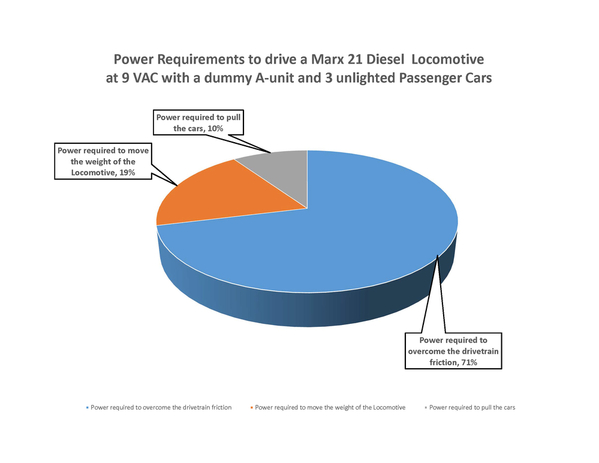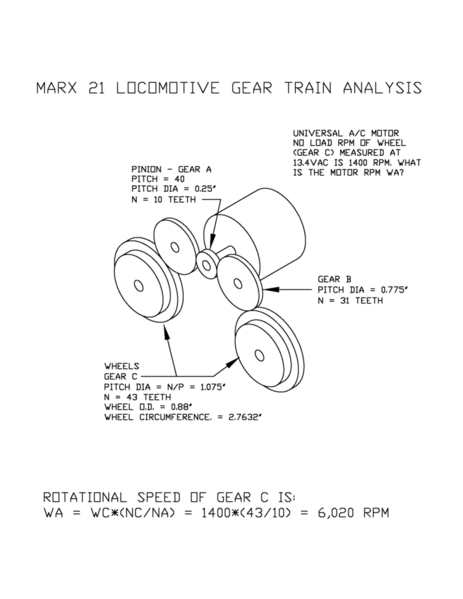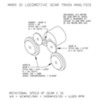I did some bench testing and conducted some time trials with my Marx 21 Diesel F-3 locomotive. The Marx 21 is a large, good-looking, tinplate locomotive - closer in scale to 1/48th rather than most of the other Marx tinplate trains which are at 1/64th scale. It weighs 2 lbs and 10.6 ounces.
My test rig, instrumentation and methods are described above.
I first bench tested the locomotive at 9 VAC, and the motor's amp draw was 1.85A, 16.65 Watts. Bench testing like this allows me to get a good idea of how much power it takes just to overcome the combined friction loss of the drivetrain.
I ran the locomotive only on the track described above, and measured the elapsed time to cover 5 laps, while also measuring the amperage, at 7, 8, 9, and 10 VAC. I did not go outside this range because the locomotive wouldn't run consistently at voltages less than 7, and would run dangerously fast at voltages greater than 10. It's worth noting that the Marx 21 operates in a narrow band of voltages like to 999, but the band of voltages is higher. My results are:
Without a dummy A-unit or passenger cars
| TRACK VOLTAGE | Elapsed Time MIN | Speed FPM | Motor RPM | Speed MPH | Scale MPH | Amp Readings | Power Watts |
| 7 | 1.5223 | 44.1549 | 824.4 | 0.50 | 24.1 | 2.2 | 15.4 |
| 8 | 0.4855 | 138.4490 | 2585.0 | 1.57 | 75.5 | 2.25 | 18 |
| 9 | 0.4003 | 167.9166 | 3135.2 | 1.91 | 91.6 | 2.35 | 21.15 |
| 10 | 0.3700 | 181.6676 | 3392.0 | 2.06 | 99.1 | 2.4 | 24 |
I then ran the locomotive with its dummy unit and three unlighted passenger cars on the track described above, and measured the elapsed time to cover 5 laps, while also measuring the amperage, at 8, 9, and 10 VAC. I did not go outside this range because the locomotive wouldn't run consistently at voltages less than 8, and would run dangerously fast at voltages greater than 10. My results are:
With dummy A-unit and three unlighted passenger cars:
| TRACK VOLTAGE | Elapsed Time MIN | Speed FPM | Motor RPM | Speed MPH | Scale MPH | Amp Readings | Power Watts |
| 8 | 1.5672 | 42.8899 | 800.8 | 0.49 | 23.4 | 2.52 | 20.16 |
| 9 | 0.5538 | 121.3741 | 2266.2 | 1.38 | 66.2 | 2.6 | 23.4 |
| 10 | 0.4445 | 151.2193 | 2823.5 | 1.72 | 82.5 | 2.65 | 26.5 |
It is interesting to compare and contrast the results when the 21 locomotive was operated at 9 VAC. On the bench, the power requirement was 16.65 watts. On the track without anything in tow, the power requirement was 21.15 watts. On the track with a dummy A-unit and three passenger cars in tow, the power requirement jumped up to 23.4 watts.
The operation of the Marx 21 is very fast. It's almost too fast, with a tendency to derail on curves at voltages above 10 VAC.










